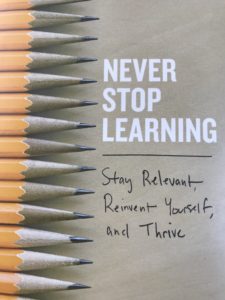
“The illiterate of the 21st Century
will not be those who cannot read and write,
but rather those who cannot learn,
unlearn and relearn” – A. Toffler
It’s been almost two years since I retired. As I reflect on what has been accomplished, I’ve come to the realization that much of it is a result of a commitment to the idea of “continuous improvement”. Simply put, I can be a better person tomorrow that I am today if I make a commitment to Never Stop Learning. I’ve learned that life is a classroom. I’ve pursued coursework through on-line venues , enhanced my sailing skills through classroom and on-water experiences, started a consulting/coaching business, read voraciously, and established numerous new networks that enable me to gain differing perspectives on our community and world.
We live in a world of continuous change. If there was ever a time that individuals and organizations needed to learn the skills to become dynamic learners, it is now. This is the subject of Bradley Statts new book, Never Stop Learning, published by Harvard Business Review Press. Statts believes that the nature of today’s economy (one that embraces technological automation, globalization, and communication technology) dictates that we continue learning, both as individuals and organizations, or risk becoming irrelevant. However he believes we must change our approach to learning, “We’re bad at learning. Supremely bad. In fact, we are our own worst enemies. Instead of doing the things that will help us learn, we often do just the opposite.” Statts proposes that we need to embrace the idea of “Dynamic Learning”, an approach to learning that emphasizes not just the acquisition of knowledge, but the sharing of and use of knowledge to build more knowledge. How? He identifies eight key elements necessary to become a dynamic learner and then dedicates a chapter to each. They include:
- Valuing failure – Dynamic learners are willing to fail in order to learn.
- Process rather than outcome – Dynamic learners recognize that focusing solely on outcome is misguided, because we often fail to recognize how we arrived. Focusing on process frees us to learn.
- Asking questions rather than rushing to answers – Dynamic learners recognize that, “I don’t know”, immediately followed by a question is a fair place to start.
- Reflection and relaxation – Dynamic learners fight the urge to act for the sake of acting. They recognize that when things get difficult, they need to stop, think, recharge and then act.
- Being yourself – Dynamic learners don’t try to conform, they are willing to be the ones who are standing out.
- Playing to Strengths – Dynamic learners don’t spend time addressing irrelevant weaknesses. They know their strength and they play to them.
- Specialization and variety – Dynamic leaders build a T-shaped portfolio of experiences that are deep in one area or more, and broad in others.
- Learning from others – Dynamic learners recognize that learning is not a solo experience. There is much to be gained from the knowledge of others.
Are you a dynamic learner? Equally important, does your organization subscribe to these ideas. Success in the 21st century necessitates a command of the learning economy. This will demand that we approach learning from a dynamic perspective, and our approach to learning will require us to have mindsets that are focused, fast, frequent and flexible. Individuals and organizations that embrace a dynamic approach to learning will have a distinct advantage as they relearn the skills necessary for success in an ever-changing world. Embrace the Challenge!
